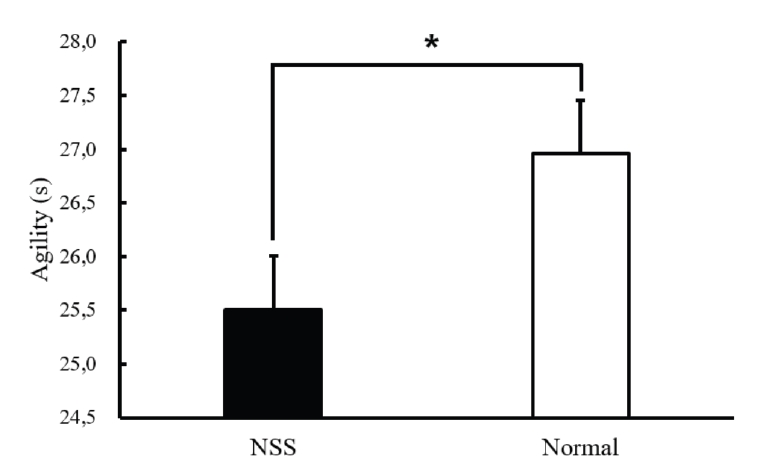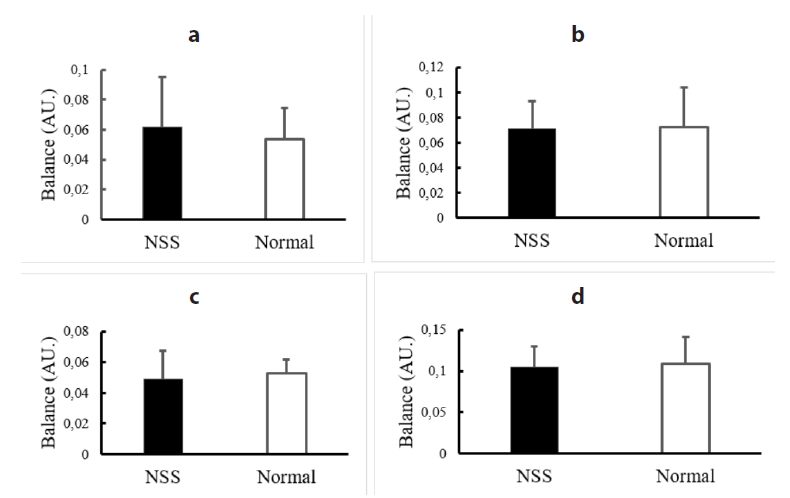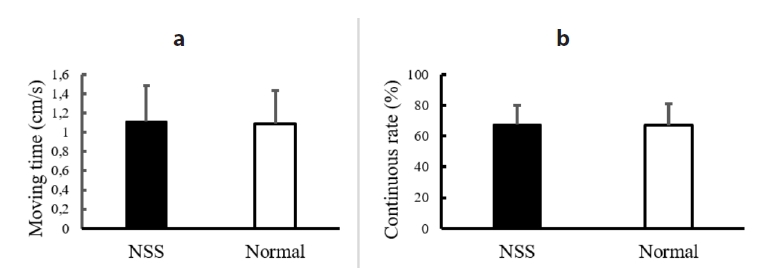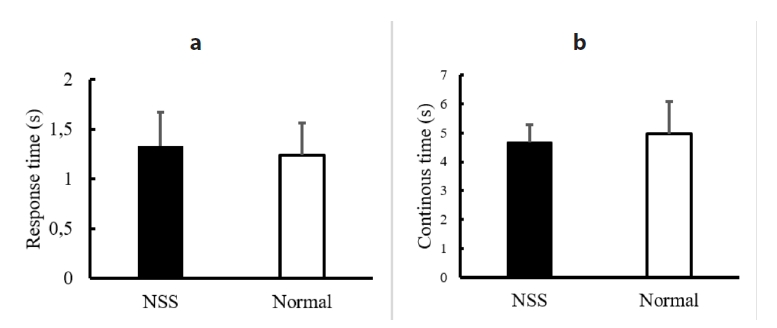Effect of Non-Slip Socks-Induced Foot Stability on Agility in Healthy Elderly Women
Article information
Abstract
OBJECTIVES
The risk of falls increases due to decrease in balance ability in elderly. A safe environment that can prevent slipping in daily life is required to prevent falls. The purpose of this study is to analyze the effect of socks with non-slip pads on improving foot stability and balance in the elderly.
METHODS
Sixteen older women aged 67-87years complete tests while wearing non-slip socks and/or normal socks. Measurements were taken for body composition, static and agility/dynamic balance, and self-reported wearing sensation.
RESULTS
Agility/dynamic balance was higher in the non-slip socks group than that in the normal socks group (p <0.05). The static balances did not differ significantly between the two groups (p>0.05). There were no differences between the two groups in terms of comfort, thermal, wet, tactile, and fit sensations according to the wearing of the socks (p>0.05). Significant higher stability sensation was observed in non-slip socks group than normal socks group (p <0.05).
CONCLUSIONS
These results suggested that the use of non-slip socks will help to prevent falls that may occur during indoor or outdoor activities and also improve exercise performance in the elderly.
Introduction
The elderly population is increasing faster than other age groups in Korea. In 2000, the elderly population aged 65 and over accounted for 7.2% of the total population and steadily increased to 12.8% in 2015 and is expected to become a super-aged society, at 20%, in 2026 [1]. National medical expenses per person increased by an average of 5.7% per year from 2009 to 2016 due to the increase in the aging population, a rate significantly higher than the 1.4% increase in Organization for Economic Cooperation and Development (OECD) countries [2]. This increase in expenses is closely related to various diseases and injuries that occur mainly in old age with an increase in the number of elderly people.
Among these, the risk of falls increases because of a decrease in body coordination, leading to reduced balance and decreased muscle mass in this population [3]. Body coordination is closely related to age. Age-related decrease in muscle mass (atrophy) [4] and muscle strength, loss of sensory systems such as visual, vestibular and somatosensory that plays an important role to control the balance result in impairment of body coordination [5-7]. Reducing the risk of injury and decreased exercise performance caused by reduced coordination with age requires increasing muscle mass and improving muscle strength through regular exercise, as well as preventing the deterioration of sensory system functions related to balance ability. A previous study reported that regular exercise training in the elderly is effective in preventing injuries such as falls by maintaining muscle strength and balance ability [8].
Falls occur most frequently in the house during daily life, with slipping the most common fall type in the elderly (59%) [9]. Thus, a safe environment that can prevent slipping in daily life is required to prevent falls. The most basic way for the elderly to prevent slipping during daily life and exercise is to ensure the stability of the foot in contact with the ground. To do so, various types of auxiliary equipment such as high stability shoes have been widely used. The most basic element to increase foot stability during indoor and outdoor activities is to wear appropriate socks to prevent slipping between the foot and the ground/shoe. In addition, when the elderly falls, wearing protective equipment such as hip protectors reduces the risk of hip fracture [10].
A recent study assessed the effects of socks with special attached anti-slip pads on exercise performance. The results showed the socks effectively improved comfort and ability to change direction during exercise [11]. Joo [12] also reported that wearing socks with non-slip pads improved athletic exercise performance compared to wearing normal socks. However, these studies were conducted among participants from the general public in their twenties and elite athletes with high levels of physical fitness induced by long periods of training. No studies have evaluated the effect of foot stability on balance in elderly individuals at high risk of falls through slipping during activities of daily life and exercise. Thus, this study analyzed the effect of socks with non-slip pads on improving foot stability and balance in the elderly.
Methods
Subjects
The participants were 16 older women (74.1±4.4 years) with no restrictions on physical activity or history of injuries or surgeries that would limit physical movement within the last 3 months. Their physical characteristics are shown in <Table 1>. The participants completed balance tests while wearing non-slip socks and/or normal socks. As shown in Figure 1, the non-slip socks had a non-slip urethane pad attached to the bottom. The normal socks were made of the same material as non-slip socks but without the non-slip pad (Wefoot technology, Bucheon, Korea).
Procedures
The participants signed a consent form after receiving a full explanation of the study. The experiment was conducted at the Senior Welfare Center in Seoul. After arriving at the center, the participants rested for 15 min after changing clothes under normal room temperature (22 ± 0.5°C). Next, the participants selected an envelope containing a slip of paper upon which was written the experimental conditions (NSS or Normal) for randomization. The body composition of the participants was analyzed using an instrument (Inbody 570, InBody Co. Ltd., Seoul, Korea). The balance test was performed in the order of static (visual, vestibular, somatosensory) and agility/dynamic balance. Finally, a questionnaire was administered to assess the wearing sensation of the socks (comfort, thermal, wet, tactile, fit, stability). After the first experiment, the next experiment was conducted using the same procedures, with a sufficient interval between experiments. All procedures performed in the current study were approved by Kangwon National University Ethics Committee (KWNUIRB-2021-07-019-001).
Agility/dynamic balance test
The method for measuring agility/dynamic balance is presented in <Figure 2>. The participants were instructed to wait while seated in a chair without armrests, then to turn the cone on the right rear side from inside to outside according to the “start” signal, and sit on the chair. After sitting, the participants rose the chair again without resting and returned the cone on the left rear from the inside to the outside before returning to sit on the chair. The participants completed the test twice, with the faster time used for the analyses.
Static balance test
The static balance test comprised the modified Clinical Test of Sensory Interaction in Balance (mCTSIB), integrated balance ability, reaction time, and latent reaction time [13]. The static balance test was performed using the balance measuring instrument (FRA510s, InBody Co. Ltd., Seoul, Korea). The static balance test was performed in the order of mCTSIB, integrated balance ability, reaction time, and latent reaction time. The participants were allowed to rest for 1 minute after each test. The mCTSIB was measured under the following four conditions: standing on a firm surface with eyes open/eyes closed, standing on a foam surface with eyes open/eyes closed for 30 seconds. Integrated balance ability comprised the shifting velocity (how fast the participants shifted their center of pressure) and target tracking (how successfully the participants pursued a moving target and moved their center of pressure) tests. The reaction and latent reaction times were measured as the time taken for the participants to touch and remove their finger from the button and press the illuminated button on the computer screen, respectively.
Questionnaire
The questionnaire used to analyze the wearing sensation of socks was modified from those described previously [14]. The questionnaire asked the participants about their sensations related to comfort (7 points), thermal (9 points), wet (7 points), tactile (5 points), fit (5 points), and stability (5 points).
Statistical analysis
Statistical analyses were conducted using IBM SPSS Statistics ver. 23.0 (IBM Co., Armonk, NY, USA). A paired t-test was performed to compared the differences between two goups (NSS vs. Normal). The alpha level for evaluation of statistical significance was set at p <0.05. The data are presented as the mean ± standard deviation.
Results
Agility/dynamic balance test
<Figure 3> shows the means and SDs of the agility/dynamic balance test times. The agility/dynamic balance times were 25.5±3.0 s and 27.0±3.7 s in the NSS and Normal groups, respectively. Agility was higher in the NSS group than that in the Normal group (p <0.05).
Static balance test
mCTSIB
The results of balance on a firm surface with eyes open/eyes closed and a foam surface with eyes open/eyes closed are shown in <Figure 4>. The mCTSIB values for the NSS and Normal groups on a firm surface were: eyes open (0.06±0.03, 0.05±0.02)/eyes closed (0.07±0.02, 0.07±0.03). The values on a foam surface were: eyes open (0.05±0.02, 0.05±0.01)/eyes closed (0.11±0.03, 0.11±0.03). The mCTSIB did not differ significantly between the two groups (p>0.05).
Integrated balance ability
<Figure 5> shows results of integrated balance; namely, quickly moving and maintaining the center of pressure to the target. The rates to shift the center of pressure to the target were 1.12±0.37 cm/s and 1.09±0.35cm/s in the NSS and Normal: groups respectively, and 67.6±12.3% and 66.9±14.4% to maintain the pressure on the target. The integrated balance ability was similar between the two groups (p>0.05).
Reaction and latent reaction times
The reaction and latent reaction times as tests of nervous system ability are shown in Figure 6. The reaction time (NSS: 1.3±0.3s, Normal: 1.2±0.3s) and latent reaction time (NSS: 4.7±0.6, Normal: 5.0±1.1s) did not differ significantly between the two groups (p>0.05).
Wearing sensation
The subjective wearing sensations are shown in <Table 2>. We observed no differences between the two groups in terms of comfort, thermal, wet, tactile, and fit sensations according to the wearing of the socks (p>0.05). However, the NSS group reported a significantly higher stability sensation compared to normal socks (p <0.05).
Discussion
This analyzed the effect of the use of non-slip socks to improve foot stability on the agility/dynamic balance and static balance of the elderly. Wearing non-slip socks improved movements that require quick changes in direction in this population but did not affect static balance ability based on the nervous and sensory systems.
Agility/dynamic balance ability is an important physical factor for fall prevention and quality of life in the elderly [15]. The agility/dynamic balance ability of participants in this study (NSS: 25.5±3.0s, Normal: 27.0±3.7s) was lower than that of European male and female elderly (male: 19±5s, female: 23±4s) reported previously [16]. These differences may be associated with participant age, as the age of the participants in the present study (67-87 years) was higher than that of the participants in the previous study (men: 61-78 years, women: 60-79 years). Moreover, the agility/dynamic balance ability of the previous study with younger than the current study was higher [17]. The other previous study reported that the ability was lower with older participants compared to the current study [18].
The agility/dynamic balance of the elderly was higher when wearing non-slip socks compared to regular socks in the current study. These findings support those of a previous study conducted on elite soccer players in our laboratory [12]. The elite soccer players showed no difference between non-slip and normal socks when performing exercises without direction change; however, non-slip socks were more effective than normal socks when performing exercises requiring sudden changes in direction. Thus, changes of direction can be performed more quickly by preventing foot slippage via the use of the silicone pad attached to the non-slip socks. Indeed, foot stability was higher in the NSS group in the current study. However, since the measurement of foot stability is a subjective score based on questionnaire responses, additional research, is needed to analyze the effects of non-slip socks on balance using various scientific instruments for objective results.
Balance ability is important for standing with a correct posture or to move the body properly in any direction. Balance ability is closely related to muscle strength and the sensory systems (visual, vestibular, somatosensory) [19, 20]. Previous studies reported that decreased balance ability in older adults is accompanied by decreases in muscle strength and sensory system functions [20, 21]. The present study assessed balance ability in the elderly using an instrument to measure visual, vestibular, and somatosensory functions. mCTSIB did not differ between the groups. The reason for these results can be associated with the study design consisting of the participants completing the tests (NSS and normal) repeatedly, which in the sensory systems were not changed between tests. In addition, the stability of the foot through the non-slip socks would not have affected the test results because of the static motion of the test method standing in place, which did not include dynamic motion such as direction change motion.
Dynamic motions requiring movement of the human body in any direction are achieved through complex and continuous interactions between cognition and the motor system [22]. In the elderly, the risk of falls may increase with decreased balance ability and functions of the sensory and motor systems. Previous studies reported that the main cause of falls in the elderly is chronic musculoskeletal or neurological impairments [23] and that elderly individuals with cognitive impairment have a higher probability of falling compared to unaffected elderly [24]. In the present study, the ability to quickly move the center of pressure to the target and maintain the center of pressure on a moving target was measured to simultaneously measure balance ability in the nervous and sensory systems. We observed no significant differences between the groups for both values. These results can be attributed to the measurement methods used. In other words, the small difference in the foot area according to the type of sock (NSS vs. Normal) was not sufficient to significantly change the values as moving only the center of pressure to the target point on the computer screen could be performed without moving the foot.
Response-ability is important to perform rapid physical movements in response to a certain stimulus. A high level of response-ability is required for successful exercise performance and the prevention of risky situations. Reaction ability is closely related to age, and healthy elderly people have slower reaction times than younger people [25]. The response-ability of the elderly is crucial in preventing falls during daily activities. Lajoie and Gallagher [26] reported that elderly without a fall history showed significantly faster reaction times compared to those with a fall history. In the present study, the response-ability did not differ significantly between the two groups. However, these participants were elderly women without serious injuries due to a fall experience and physical limitations in movement. Therefore, there appeared to be no difference in reaction ability according to the type of socks.
This study has several limitations. First, the participants included only women >65 and we did not analyze the balance according to the type of socks in male elderly participants. Second, due to difficulties in recruitment owing to the coronavirus disease 2019 pandemic, the number of participants was insufficient to observe significant statistical results. Third, indoor measurements were limited due to the strengthening of the government’s quarantine guidelines; thus, it was not possible to conduct experiments that included movements requiring a sudden change in motion to verify the effectiveness of wearing non-slip socks. Forth, although there was sufficient interval between experiments, it seems that the test results were affected by the learning effect of the participants. Therefore, additional studies are needed to analyze the effect of foot stability on the prevention of falls and physical activity in the elderly through various experiments including many subjects, such as elderly men, for more scientific and reliable findings.
Conclusion
The results of this study demonstrated that non-slip socks intended to improve foot stability in the elderly were effective in improving exercise performance. The non-slip socks group showed better performance in the agility/dynamic balance test, which required a sudden change in motion. However, the static balance ability measured on the platform of the balancing ability instrument did not differ between the groups. These results suggested that the use of non-slip socks will help to prevent falls that may occur during indoor or outdoor activities and also improve exercise performance in the elderly.
Notes
The authors declare no conflict of interest







